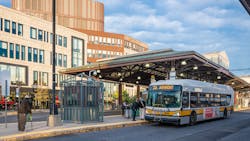Boston is set to expand fare-free program to three routes in March
The city of Boston will expand its fare-free program starting March 1 to three Massachusetts Bay Transportation Authority (MBTA) bus routes following the successful pilot program on Route 28. With the program’s expansion, Route 28 will remain fare-free for two years and will be joined by Routes 23 and 29.
Boston Mayor Michelle Wu is working to “make public transit a public good.” The city is using $8 million in American Rescue Plan funds to make the two-year fare-free program a reality.
“Expanding fare-free transit to Routes 23, 28, 29 will better connect our communities, increase ridership and ease congestion for all our residents,” said Mayor Wu. “As we work to ensure every resident knows about the program, we hope this is just the beginning of access to fare-free public transit in Boston. I'm thrilled to partner with the MBTA to expand this successful ongoing program and look forward to working with our partners across the commonwealth to build a sustainable, reliable, accessible and affordable transportation system that truly serves our residents and our local economy.”
The city explains Routes 23, 28 and 29 all travel through and along Blue Hill Avenue, serve a diverse ridership and provide connections to communities underserved by the existing network. Additionally, the routes have some of the highest ridership throughout the city.
The pilot program began on Route 28 in August 2021 with the city noting ridership on the route increased to more than 90 percent of pre-pandemic levels after fares were eliminated.
Route 28 rider Peggy James called the Route 28 fare-free program a blessing.
“All of my daily activities, including going grocery shopping, heading to the laundry and picking up my medicine, have been made easier due to this program. Since the fare-free program was implemented, my commutes have been a lot more enjoyable, with less hiccups and stalling at bus stops along the route,” said James.
The city and MBTA have been regularly meeting and partnering to work out specifics of the program. The city says the expansion of the program provides it and the MBTA, as well as other transit providers, an opportunity to measure the benefits of fare-free bus service, such as increased ridership, faster buses, less traffic and business development, over a longer period of time. For example, early analysis of the Route 28 pilot program suggests that all-door boarding allowed during fare-free service reduced dwell time by more than 20 percent.
“We were pleased to collaborate with the city on the Route 28 pilot and now to expand the program to include these additional routes for the next two years,” said MBTA General Manager Steve Poftak. “The benefits experienced by customers on the 28 are being expanded to a broader group of riders and we appreciate the city of Boston’s willingness to make this happen by providing funding.”
About the Author

Mischa Wanek-Libman
Group Editorial Director
Mischa Wanek-Libman is director of communications with Transdev North America. She has more than 20 years of experience working in the transportation industry covering construction projects, engineering challenges, transit and rail operations and best practices.
Wanek-Libman has held top editorial positions at freight rail and public transportation business-to-business publications including as editor-in-chief and editorial director of Mass Transit from 2018-2024. She has been recognized for editorial excellence through her individual work, as well as for collaborative content.
She is an active member of the American Public Transportation Association's Marketing and Communications Committee and served 14 years as a Board Observer on the National Railroad Construction and Maintenance Association (NRC) Board of Directors.
She is a graduate of Drake University in Des Moines, Iowa, where she earned a Bachelor of Arts degree in Journalism and Mass Communication.
